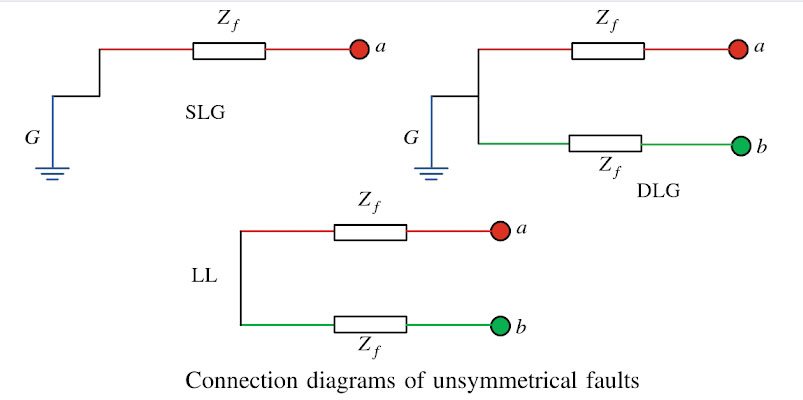Irrespective of the causes, which is the fault in a 3-phase system?
Right Answer is:
Both symmetrical fault and Unsymmetrical faults
SOLUTION
The fault in the power system is generally categorized into two type
- Symmetrical fault
- Unsymmetrical fault
Symmetrical Fault
The symmetrical faults are often known as balanced faults. In case of balanced faults, all three transmission lines are affected equally, and the system remains in the balanced condition. These types of faults are rare in the power system, and it contributes 2 % to 5 % of the total fault. These faults are easy to analyze. The symmetrical faults are classified as three lines to ground fault (LLLG) and three lines fault (LLL). The connection diagrams of symmetrical faults are shown in Fig. If the fault impedance, Zf = 0, then the fault is known as a solid or bolted fault.

Unsymmetrical Faults
The faults in the power system network which disturb the balanced condition of the network are known as unsymmetrical faults. The unsymmetrical faults are classified as the single line to ground faults (SLG), double line to ground faults (DLG 10%) and line to line faults (LL 15%). More than 90 % of faults occur in a power system are the single line to ground faults. The connection diagrams of different types of unsymmetrical faults are shown in Fig.

Some of the examples of three-phase and three-phase to earth fault are as follows:
- The earth switch at one end of a high-voltage line is in a closed state and the breaker at the other end is closed
- Terminals of a transformer are shorted for testing and some one may have forgotten to remove the short before energizing the transformer
- A cable is cut by accident, across all the conductors
- The terminals of a low-voltage cable are shorted for testing or similar reasons and the cable is energised without removing the short
- While working on a live distribution board or small MCC a technician may touch the bus bars by accident. This can happen when the three bus bars or three terminals are very close in a distribution board or a small MCC (the clearance between phases is only 25 mm).
In a three-phase, and three-phase to earth faults the current is the same because the fault current floe through the phase conductors only and cancels out. No current flows through the earth return path.
Single-phase to earth fault is the most common fault and examples are:
- A terminal of a cable/transformer is earthed for testing and cable/transformer is energised without removing the short
- Technician working in a live board may touch a phase by accident or the spanner may bridge a phase and earth (enclosure)
- Live conductor may couch the earthed pares due co insulation failure (such as due to aging)
- Damage to a cable or an equipment due to accident Loose termination Cable may cut into a sharp object
- Tracking of termination
- Moisture leakage
For three-phase circuits the highest fault current of all the above types of faults, is used to select the fault capacity of a device. In the vicinity of a generating station or generator, a single-phase to earth fault can be higher than a three-phase fault. For a single-phase circuit, a single-phase to earth fault current is used to decide the fault capacity of an equipment or device. For residential, commercial and industrial systems only three-phase and single-phase to earth fault are considered because generally these produce the highest fault current and are the most likely faults.
